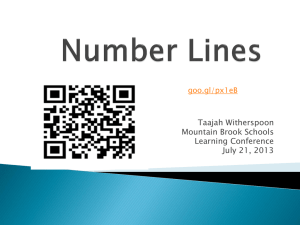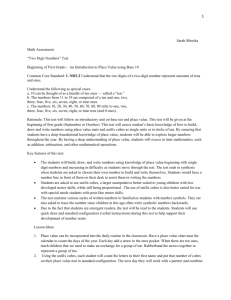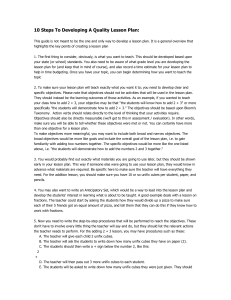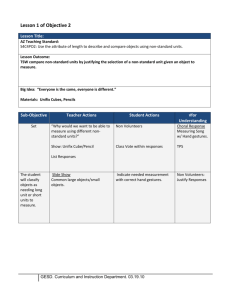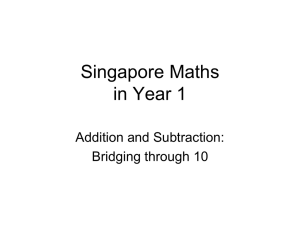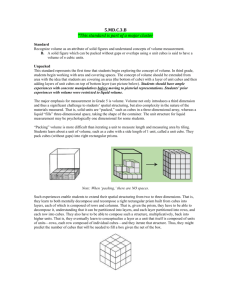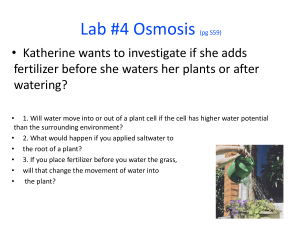Comparing and Measuring
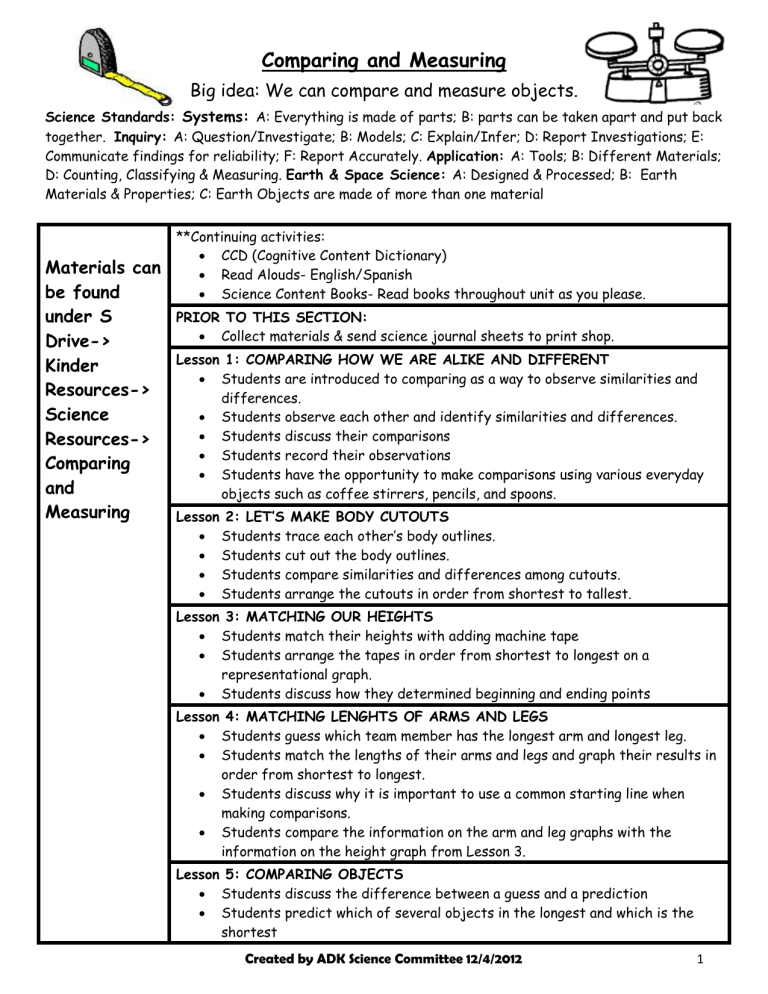
Comparing and Measuring
Big idea: We can compare and measure objects.
Science Standards:
Systems:
A: Everything is made of parts; B: parts can be taken apart and put back together. Inquiry: A: Question/Investigate; B: Models; C: Explain/Infer; D: Report Investigations; E:
Communicate findings for reliability; F: Report Accurately. Application: A: Tools; B: Different Materials;
D: Counting, Classifying & Measuring. Earth & Space Science: A: Designed & Processed; B: Earth
Materials & Properties; C: Earth Objects are made of more than one material
Materials can be found under S
Drive->
Kinder
Resources->
Science
Resources->
Comparing and
Measuring
**Continuing activities:
CCD (Cognitive Content Dictionary)
Read Alouds- English/Spanish
Science Content Books- Read books throughout unit as you please.
PRIOR TO THIS SECTION:
Collect materials & send science journal sheets to print shop.
Lesson 1: COMPARING HOW WE ARE ALIKE AND DIFFERENT
Students are introduced to comparing as a way to observe similarities and differences.
Students observe each other and identify similarities and differences.
Students discuss their comparisons
Students record their observations
Students have the opportunity to make comparisons using various everyday objects such as coffee stirrers, pencils, and spoons.
Lesson 2: LET’S MAKE BODY CUTOUTS
Students trace each other’s body outlines.
Students cut out the body outlines.
Students compare similarities and differences among cutouts.
Students arrange the cutouts in order from shortest to tallest.
Lesson 3: MATCHING OUR HEIGHTS
Students match their heights with adding machine tape
Students arrange the tapes in order from shortest to longest on a representational graph.
Students discuss how they determined beginning and ending points
Lesson 4: MATCHING LENGHTS OF ARMS AND LEGS
Students guess which team member has the longest arm and longest leg.
Students match the lengths of their arms and legs and graph their results in order from shortest to longest.
Students discuss why it is important to use a common starting line when making comparisons.
Students compare the information on the arm and leg graphs with the information on the height graph from Lesson 3.
Lesson 5: COMPARING OBJECTS
Students discuss the difference between a guess and a prediction
Students predict which of several objects in the longest and which is the shortest
Created by ADK Science Committee 12/4/2012 1
Students use adding machine tape to match the length of the large objects
Students discuss the results recorded on a class graph.
Lesson 6: MATCHING DISTANCE
Students discuss various ways of matching distance
Students explore how to make the Flippers move.
Students compare the distance of 3 jumps
Students use adding machine tape to match distance
Students discuss their results and observations
Lesson 7: USING OUR FEET TO MEASURE
Students take 5 heel-to-toe steps and match the length covered.
Students record the results on a graph
Students discuss and compare results
Students discuss why the tapes are different lengths
Students listen to and discuss a story about nonstandard units of measure
Lesson 8: USING DIFFERENT STANDARD UNITS OF MEASURE
Students discuss what they are now know about measuring
Students measure the lengths of objects using various sets of standard units
Students record the results
Students compare and discuss their results.
Lesson 9: MEASURING WITH A STANDARD UNIT
Students use coffee stirrers to measure the lengths of objects.
Students record their results by gluing the coffee stirrers to a length of adding machine tape matched to the length of the object.
Students record, compare, and discuss their results.
Students label their results with the name of the unit.
Lesson 10: EXPLORING WITH UNIFIX CUBES
Students reflect on what they have learned about measuring in the last 3 lessons.
Students compare coffee stirrers with unfix cubes as units of measure
Students measure using unifix cubes
Students discuss their measuring experiences
Lesson 11: COUNTING LARGE NUMBERS OF UNITS
Students measure long objects using unifix cubes
Students record their results
Students discuss why it is useful to group cubes into tens when measuring
Lesson 12: MEASURING THE HEIGHT OF THE TEACHER
Students predict the height of the teacher in unifix cubes
Students use unifix cubes to measure a strip of adding machine tape that represents the teacher’s heights
Students record their results
Students compare and discuss their results
Lesson 13: MAKING A MEASURING STRIP
Students discuss the relative usefulness of the different measuring units they have explored
Students use unifix cubes to make their own measuring strips
Created by ADK Science Committee 12/4/2012 2
Students compare their measuring strip with a stick of 10 unifix cubes.
Students discuss the advantages of using the measuring strips rather than unifix cubes.
Lesson 14: MEASURING WITH A MEASURING STRIP
Students measure objects that are longer than their measuring strips.
Students compare and discuss the strategies they used to measure the objects.
Students discuss the advantages and disadvantages of measuring strips.
Lesson 15:MAKING A MEASURING TAPE
Students make a measuring tape.
Students use the measuring tape to measure objects.
Students discuss the advantages of using a 100-unit measuring tape rather than a 10-unit measuring strip when measuring longer objects.
Students measure around objects
Students listen to and discuss a reading selection about a long measuring to
Lesson 16: USING A MEASURING TAPE TO MEASURE DISTANCE
Students predict how far they can make the Flippers travel.
Students use their measuring tapes from Lesson 15 to determine the longest distance the Flippers travel.
Students record their results.
Students compare the results obtained by measuring with the results obtained by matching.
Lesson 17: POST-UNIT ASSESSMENT
Created by ADK Science Committee 12/4/2012 3
Comparing & Measuring Cognitive Content Dictionary
Vocab. Word Definition
Compare/Comparar To see the similarity or differences in something
Measuring/Medir
Ascertain the size, amount, or degree of (something) by using an instrument or device marked in standard units or by comparing it
Gesture
Place hands like a balance and move them up and down to show how you are comparing.
Move hands to the sides and up and down to show that you are measuring length, width, height, speed, etc.
Picture
Title English
Possible Read Alouds
Title Spanish Publisher
Created by ADK Science Committee 12/4/2012 4
